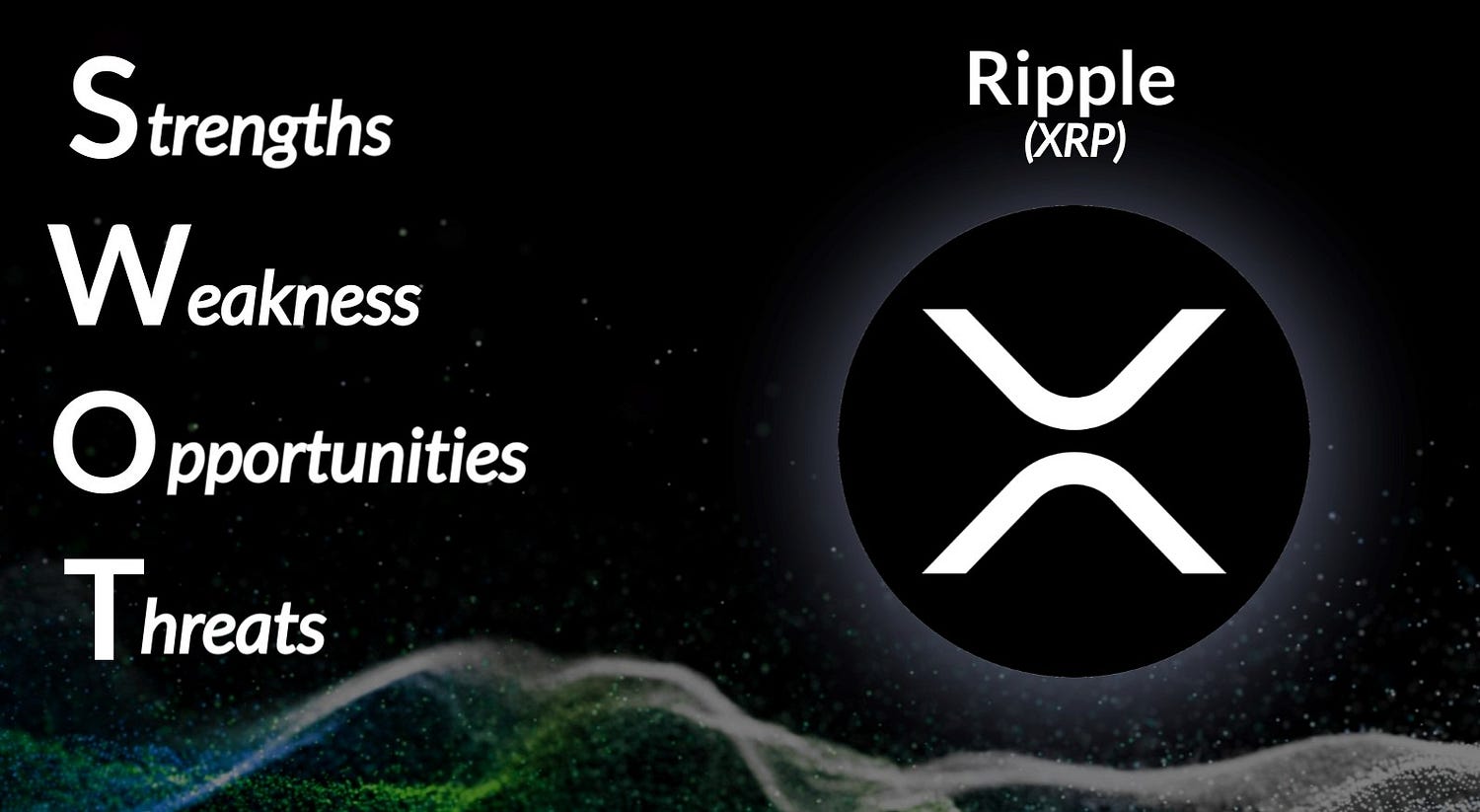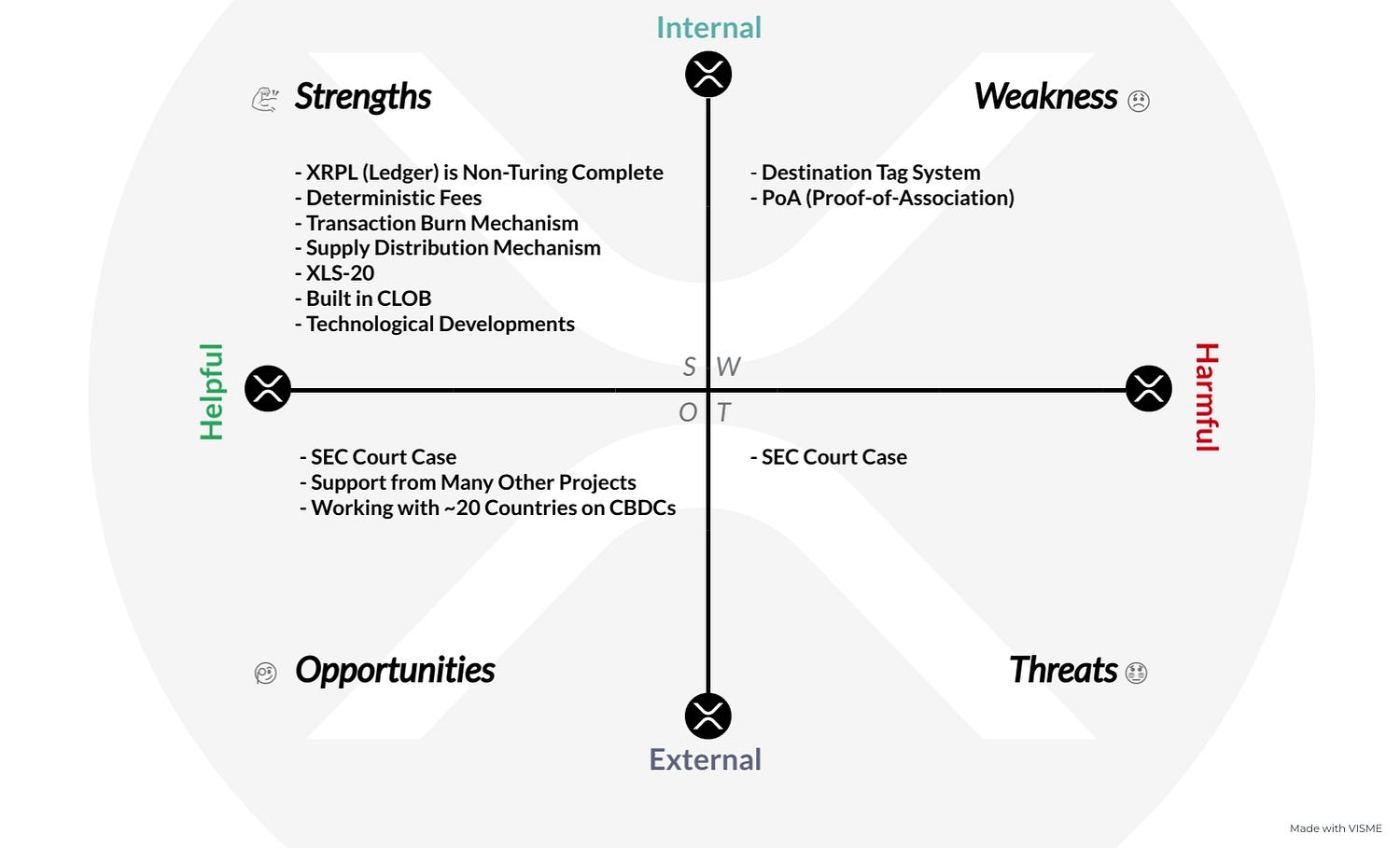
SWOT Analysis: Ripple (XRP)
*Note: a SWOT analysis is an evaluation of the fundamental, operational, technical, social, economic, and even to some degree administrative elements of a project. This is not a model to be used for trading purposes. (NFA, DYOR)

Composed of four elements, Strengths, Weaknesses, Opportunities, and Threats, a SWOT analysis framework provides excellent insight for establishing a high-level understanding of the state of a project’s well-being through the lens of a birds-eye view.
It can help formulate decisions around which areas require more attention, set performance goals, and organize a foundational understanding of where a project is headed.
Rarely (if ever) used in crypto, it is time to apply this timeless method of evaluation to the digital asset space.
Today, Ripple (XRP), the most controversial OG crypto project, full of legal shenanigans, enterprise-grade technology, and die-hard community members, will get a SWOT.

1. XRPL (Ledger) is Non-Turing Complete
The Ledger used by Ripple is actually structurally reminiscent of Bitcoin and diametrically different from Ethereum. The XRPL is not able to support arbitrary computations or smart contracts; this was a design choice deliberately made by Ripple Labs in order to guarantee a higher level of stability and security for the network. By laser-purposing XRPL for a specific type of transaction (payments), the inherent negative externalities and uncertainties around smart contracts are avoided.
2. Deterministic Fees
Something very unusual in the crypto landscape is stability; be it price, fees, user count, or any other metric, crypto is notorious for its volatility. Ripple’s ledger is the first of its kind to offer a model for fees that is set at 10 “drops” which translates to (1/100,000) of an XRP. With a predictable fee structure, a much more effective payment system can be built and a higher degree of transaction confidence would be experienced by users. This is in stark contrast to the tranny of Etheruem’s gas fees that are ridiculously hard to calculate and have historically spiked upwards into the hundreds of dollars.
3. Transaction Burn Mechanism
Every single transaction on XRPL demands that a tiny portion of the token supply is burned. While the exact amount can vary, the base requirement is 10 drops or 0.00001 XRP, which has so far averaged out to somewhere between 5,000–10,000 XRP being burned per day (with massive outlier spikes, of course). The presence of the Burn mechanism exudes constant delayed pressure on upkeeping the token’s value as well as deterring network spam. Thus far, >11,000,000 XRP has been burned since inception; which is insignificant when considering how long it has been and how much more tokens still need to make it into circulation.
4. Supply Distribution Mechanism
Another novel design around the token’s economics from Ripple labs. Set at a 100 Billion XRP max supply and with ~54% already in circulation, there are another >~46 Billion tokens that need to make their way to market; how this happens is arguably balanced. The non-circulating supply is locked in an escrow account that cannot be forced open, every month 1 Billion tokens are unlocked/vested to the Ripple foundation, and the foundation has to distribute those tokens within the month, if they do not, the excess tokens are returned back to the escrow wallet and the cycle repeats itself. This will happen indefinitely until all tokens are in circulation.
5. XLS-20
In October of 2022, Ripple released the XLS-20 standard framework, which brought NFTs to the XRPL ecosystem. Given that the overall potential market size of NFTs eclipses that of fungible assets, new vectors of value creation/retention and innovation are now possible on XRP. Since launch, a multitude of new communities have arrived on-chain, bringing with them activity that has (proportionately) out-performed all other network metrics in 2023.
6. Built in CLOB
Any financial/monetary system requires the presence of a venue to conduct trade; within the world of crypto, these venues are DEXs. XRPL has a CLOB (Central Limit Order Book) decentralized exchange built in that facilities trade of cryptos, tokens, and NFTs. The CLOB model is much more appealing to large traditional financial institutions (than the crypto industry’s more common AMM) because it is what they have been using historically. The CLOB is also a single point that aggregates all liquidity, providing a higher degree of depth and lower slippage with high control over the order types and their granularity.
7. Technological Developments
Ripple is constantly developing reliable, enterprise-grade technologies that keep up with the standards floating around the crypto industry, as well as those that are demanded/required by large traditional organizations and governments to operate. Currently, there is a pipeline of innovation as follows: an AMM being developed as per the XLS-30, Hooks system that will allow for semi-smart contract programmability (similar to the conditional scripts currently being used in the Bitcoin ecosystem), a Multi-chain ecosystem that leverages a variety of scaling solutions including the use of the EVM and sidechains, new identity solutions, XLS standards for off-chain transactions and improvements in the programming language used, among other things.
1. Destination Tag System
While this is a novel design that does have its merits within legacy financial circles, and it is not present in other crypto projects, it’s not one that is highly regarded by crypto natives. XRP utilizes a tracking/ownership account system where a single address has tags that allow it to manage funds on behalf of other people. Imagine a centralized exchange that has one address on XRPL and that one address receives/manages all the XRP balances of other users. Where on Bitcoin or Ethereum, every user has their own address, on Ripple’s Ledger, one address can become a bank that manages XRP funds of other people, creating micro-hierarchies/federations within the network itself. This is potentially a positive for users that do not want to deal with the headaches associated with self-sovereignty but a red flag for the freedom maximalists.
2. PoA (Proof-of-Association)
Using their own consensus model that does not have transactional or block reward incentives arouses suspicion; what does somebody have to gain by joining? Part of the argument here is that the burning mechanism will ultimately drive the value accrual for the nodes. This might prove to be a valid model that appeals to a grade of market participants who have a radically more developed psychological understanding than I might; however, from the lens of a crypto native, this does not seem appealing to newer/less capitalized actors and would translate to another model where the elites are able to secure ownership while users must just blindly trust their associations.
1. SEC Court Case
Everybody in the industry has heard about the recent outcome of the ruling by U.S. District Judge Analisa Torres. Obviously, this is far from winning any war, but this has become the first signal of intellectual clarity from a regulatory entity. Granted, her ruling is very minute and only addresses the transactions pertaining to XRP taking place between retail investors on exchange venues; still leaving a legal gap around the sales of XRP from Ripple to private investors through the use of contracts as security transactions. Nevertheless, when looking over the long term, if Ripple does manage to pull this one off, survive the legal bashing, and continue its existence; this will be an anchoring precedent for not just XRP but for the entire crypto industry. By bolstering the industry from the legal side, XRP will become a household name and forever be honored as a maverick.
2. Support from Many Other Projects
When launched, Ripple was like an ugly duckling that constantly caught heat from crypto maxis and projects about its centralization. After a decade (yes, Ripple has been around for more than 10 years now), that clamor has been more-or-less shut down, and everybody has rallied behind Ripple in support of them overcoming the legal issues they are so bravely fighting.
3. Working with ~20 Countries on CBDCs
While CBDCs are the antithesis of crypto, their arrival into the world economy is neigh but inevitable. Here we see the power of Ripple’s brand and legendary team putting in the footwork and developing relationships with a multitude of nations to leverage XRPL for the issuance of their CBDCs. Some of the known countries include Palau, Colombia, and Montenegro.
1. SEC Court Case
This element is both an opportunity if won and also a constant looming threat is things go really undesirably. In the event that XRP completely loses its court case (even though this is unlikely given the legal system’s ability to appeal basically indefinitely) that would cause crippling damage to both XRP and the industry as a whole. While this does only pertain to the jurisdictions of the US (a project as intelligent and well-resourced as Ripple, would likely find a way to continue existing outside of US oversight); having the US market is an enormous/outsized portion of the world’s money.
Ripple is an absolute Powerhouse. They are a beacon of quality and the center of attention for all those watching the regulatory developments around crypto within the US. The project is obviously ultra-high quality and the people working behind it are world class.
The technology of the project and the finesse with which it is developed (in regard to the overall finance and technology sectors) is something that many new-age projects should be learning from.
Had there been no legal issues facing Ripple, it would be feasible to consider that it would have been much further along; at the same time, seeing their relentless development (business and technology) while juggling the obnoxious legal system gives them the right to own a permanent place in the digital industry (which they already have secured).
I was actually one of the anti-ripple people back whenever I first got involved in crypto. Much of it was my own immaturity, lack of understanding, and desire to virtue signal my moral alignment with decentralization. Since then, and especially in light of the XRP vs SEC combat that began in 2020, my stance has changed. First and foremost, the very meaning of decentralization and its application to crypto/finance has now become much more concrete; projects don't have to be decentralized; the industry does; by virtue of allowing for anybody to propose anything, decentralization is present; shutting out another participant because their system is “centralized” is unwise; freedom of choice is what we seek.
Ripple will be a name that becomes synonymous with legacy giga-corporations such as Blackrock, Microsoft, and the such (I'm not saying they are the same type of companies, I'm just saying they will be equally important in their own right).
Would I invest in XRP?
Sheesh.
Let me put it this way;
Right now, today, No.
I believe there is one more strong selloff ahead for the overall industry and the recent price action is just overhyped money sloshing around (not new money coming in).
However, at the right price point (maybe ~$0.50, yes, absolutely, id grab another bag). Something in the 1%–3% range of a crypto portfolio allocation is not out of the picture.
If you know something that I don’t or feel as though I might have missed anything worth noting, please do share, I would tremendously appreciate some feedback.
Thank you so much for reading,
I hope this serves you well on your journey.
Live long and prosper 🥂


